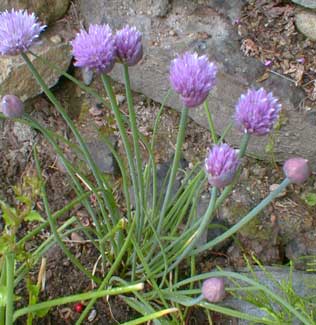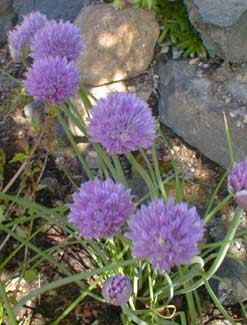
Flowering Chive
"The chives' wise heads chaperone their dreams."
-Jennifer Rose,
1995
1995
Not only does one get a nice spreading clump of ornamental grass when one plants chives (Allium schoenoprasum), but also one's own garden-fresh topping for baked potatoes, plus purple pompom flowers (or umbels) from May well into Summer. The blooms are also edible if one wishes.
As a food it is milder than leeks or garlics, subtler & more complex than most onions. The pungeance of the leaves is much the most pleasing of alliums, whether in the garden or on the table, & not so grim for one's breath. Because it is a fast-grower, leaves of a mature clump can be harvested on a pretty regular basis for kitchen use.
When used on the table the herb is called "chives" but when speaking of a single clump it is spoken of as a singular "chive." The name is from a Middle English corruption of the latin word for "onion."
 It can be chopped up with fresh skinned cucumbers & mixed with yogurt for a superior raita to use as a sauce, dip, or side-dish. The subtle flavor makes chives fine raw in salads or on baked potatoes, but chives also fries or bakes or boils perfectly well, so can be used for a vast array of cassaroles, stirfries, or soups.
It can be chopped up with fresh skinned cucumbers & mixed with yogurt for a superior raita to use as a sauce, dip, or side-dish. The subtle flavor makes chives fine raw in salads or on baked potatoes, but chives also fries or bakes or boils perfectly well, so can be used for a vast array of cassaroles, stirfries, or soups.If you've some lemon-balm in the garden, chop up some lemonbalm & chive to mix into fried eggs; frying the herbs a few moments in butter before adding the eggs is ideal. Or instead of lemon-balm, try mixing the chives with some fresh picked basil.
You'll have noticed cottage cheese & chives is a standard product offered in the milk department of most grocery stores, but how much better it is mixed at home with garden-fresh chives, as a very simple but standard East European dish.
Although chive plants are grown mostly as a vegetable, & quite a good one, they should also be considered for their ornamental strengths. I've planted many different kinds of ornamental alliums, & some either performed badly in our weather, or performed well but weren't the least bit prettier than the umbels of the humble chive.
Although the pungeance might make them too much for indoor bouquets, they do make excellent dried flowers for arrangements. When dried it loses its pungeance (also its flavor, which is why chives is always used fresh & not recommended as a dried herb).
From wee bulbs they grow one to two feet in height, spreading on thick roots that develop new small bulbs, forming a clumping groundcover to three feet wide. After three or four years the clump will weaken from overcrowding itself, & must be lifted & divided to be refreshed. They can be divided almost every year if the purpose is propogating more clumps. They divide best in winter when the leaves have died back & the clump is dormant, though here in the mild Northwest they could be divided almost anytime one wished without stressing them unduly.
There are two variants of this species, A. schoenoprasum var siberica being native to sundry parts of North America, including here in the Pacific Northwest, & A. schoenprasum var shoenprasum, which is not native to North America but has escaped gardens to naturalize as wildflowers throughout the Pacific Northwest & in the Northeast states.
It is generally recommended to deadhead the spent flowers so that they won't reseed aggressively all about the garden. Deadheading also induces rebloom for lengthened flower season. Harvesting the blooms in their prime for soups or salads serves triple-duty of inducing rebloom, stopping the clump from getting weedy, & feeding the family.
Clumps can alternatively be grown in bright shade rather than full sun. They won't flower as intensely but the edible grass will be no less a delight.